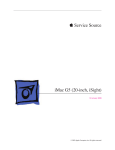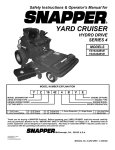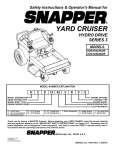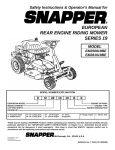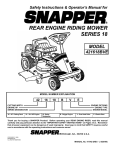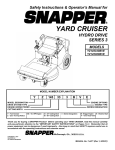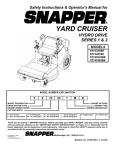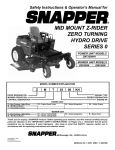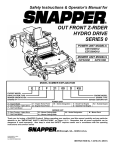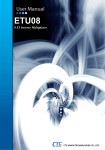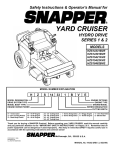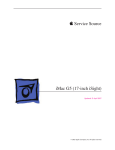Download Snapper 381451HBVE Lawn Mower User Manual
Transcript
Safety Instructions & Operator’s Manual for REAR ENGINE RIDING MOWER HYDRO DRIVE SERIES 1 MODEL 381451HBVE MODEL NUMBER EXPLANATION 38 145 1 H B V E CUTTING WIDTH ENGINE HP SERIES DESIGNATION DRIVE SYSTEM ENGINE OPTIONS ENGINE TYPE ENGINE MODEL 38 – 38” Cutting Deck 145 – 14.5 HP Engine 1 – Series Designation H – Hydrostatic Drive System B – Briggs Engine V – Over Head Valve E – Electric Start Thank you for buying a SNAPPER Product! Before operating your machine, read this manual carefully and pay particular attention to the “IMPORTANT SAFETY INSTRUCTIONS” on Pages 2 & 3. Remember that all power equipment can be dangerous if used improperly. Also keep in mind that SAFETY requires careful use in accordance with the operating instructions and common sense! COPYRIGHT © 2001 SNAPPER INC. ALL RIGHTS RESERVED MANUAL No. 7-2214 (REV. 3, 8/29/01) IMPORTANT SAFETY INSTRUCTIONS WARNING: This powerful cutting machine is capable of amputating hands and feet and can throw objects that can cause injury and damage! Failure to comply with the following SAFETY instructions could result in serious injury or death to the operator or other persons. The owner of the machine must understand these instructions and must allow only persons who understand these instructions to operate machine. Each person operating the machine must be of sound mind and body and must not be under the influence of any substance, which might impair vision, dexterity or judgment. If you have any questions pertaining to your machine which your dealer cannot answer to your satisfaction, call or write the Customer Service Department at SNAPPER, McDonough, Georgia 30253. Phone: (1-800-935-2967). PROTECTION FOR CHILDREN PROTECTION AGAINST TIPOVERS Tragic accidents can occur if the operator is not alert to the presence of children. Children are often attracted to the machine and the mowing activity. Never assume that children will remain where you last saw them. 1. KEEP children out of the mowing area and under the watchful care of a responsible adult. 2. DO NOT allow children in yard when machine is operated (even with the blade OFF). 3. DO NOT allow children or others to ride on machine or on attachments (even with the blades OFF). They may fall and be seriously injured. 4. DO NOT allow pre-teenage children to operate machine. 5. ALLOW only responsible adults & teenagers with mature judgment under close adult supervision to operate machine. 6. DO NOT operate blades in reverse. STOP BLADES. LOOK and SEE behind and down for children, pets and hazards before and while backing. 7. USE EXTRA CARE when approaching blind corners, shrubs, trees, or other objects that may obscure vision. (Continued From Previous Column) 5. STAY ALERT for holes and other hidden hazards. Tall grass can hide obstacles. Keep away from ditches, washouts, culverts, fences and protruding objects. 6. KEEP A SAFE DISTANCE (at least 3 feet) away from edge of ditches and other drop offs. The machine could turn over if an edge caves in. 7. Always begin forward motion slowly and with caution. 8. Use weights or a weighted load carrier in accordance with instructions supplied with a grass catcher. DO NOT operate machine on slopes exceeding 10 degrees (18% grade) when equipped with grass catcher. 9. DO NOT put your foot on the ground to try to stabilize the machine. 10. DO NOT operate machine on wet grass. Reduced traction could cause sliding. 11. DO NOT operate machine under any condition where traction, steering or stability is doubtful. PREPARATION 1. Read, understand, and follow instructions and warnings in this manual and on the machine, engine and attachments. Know the controls and the proper use of the machine before starting. 2. Only mature, responsible persons shall operate the machine and only after proper instruction. 3. Data indicates that operators age 60 and above, are involved in a large percentage of mowerrelated injuries. These operators should evaluate their ability to operate the mower safely enough to protect themselves and others from serious injury. 4. Handle fuel with extra care. Fuels are flammable and vapors are explosive. Use only an approved fuel container. DO NOT remove fuel cap or add fuel with engine running. Add fuel outdoors only with engine stopped and cool. Clean spilled fuel from machine. DO NOT smoke. 5. Practice operation of machine with BLADES OFF to learn controls and develop skills. 6. Check the area to be mowed and remove all objects such as toys, wire, rocks, limbs and other objects that could cause injury if thrown by blade or interfere with mowing. PROTECTION AGAINST TIPOVERS Slopes are a major factor related to loss-of-control and tip-over accidents, which can result in severe injury or death. All slopes require extra CAUTION. If you cannot back up the slope or if you feel uneasy on the slope, DO NOT mow it. Use extra care with grass catchers or other attachments; these affect the handling and the stability of the machine. 1. DO NOT operate machine on slopes exceeding 15 degrees (27% grade). 2. Exercise EXTREME CAUTION on slopes above 10 degrees (18% grade). Turn blades OFF when traveling uphill. Use a slow speed and avoid sudden or sharp turns. 3. DO NOT operate machine back and forth across face of slopes. Operate up and down. Practice on slopes with blades off. 4. AVOID uphill starts. If machine stops going uphill or tires lose traction, turn blades OFF and back slowly down the slope. 2 IMPORTANT SAFETY INSTRUCTIONS PREPARATION OPERATION (Continued From Previous Page) 7. Keep people and pets out of mowing area. Immediately STOP blades, STOP engine, and STOP machine if anyone enters the area. 8. Check shields, deflectors, switches, blade controls and other safety devices frequently for proper operation and location. 9. Make sure all safety decals are clearly legible. Replace if damaged. 10. Protect yourself when mowing and wear safety glasses, long pants and substantial footwear. 11. Know how to STOP blades and engine quickly in preparation for emergencies. 12. Use extra care when loading or unloading the machine into a trailer or truck. 13. Check grass catcher components frequently for signs of wear or deterioration and replace as needed to prevent injury from thrown objects going through weak or worn spots. (Continued From Previous Column) 14. Exercise CAUTION when pulling loads. Limit loads to those you can safely control and attach loads to hitch plate as specified with SNAPPER attachment instructions. 15. DO NOT operate engine in enclosed areas. Engine exhaust gases contain carbon monoxide, a deadly poison. OPERATION 3. MAINTENANCE 1. 2. 1. Mount and dismount machine from left side. 2. Start engine from operator's seat, if possible. Make sure blades are OFF and parking brake is set. 3. DO NOT leave machine with engine running. STOP engine, STOP blades, SET brake, and Remove key before leaving operators position of any reason. 4. DO NOT operate machine unless properly seated with feet on feet rests or pedal(s). 5. STOP BLADES and ENGINE and make sure blades have stopped before removing grass catcher or unclogging mower to prevent loss of fingers or hand. 6. Blades must be OFF except when cutting grass. Set blades in highest position when mowing over rough ground. 7. Keep hands and feet away from rotating blades underneath deck. DO NOT place foot on ground while BLADES are ON or machine is in motion. 8. DO NOT operate machine without entire grass catcher or guards in place. DO NOT point discharge at people, passing cars, windows or doors. 9. Slow down before turning. 10. Watch out for traffic when near or crossing roadways. 11. STOP engine immediately after striking an obstruction. Inspect machine and repair damage before resuming operation. 12. Operate machine only in daylight or with good artificial light. 13. Move joystick (if equipped) SLOWLY to maintain control during speed and directional changes. 4. 5. 6. 7. 8. 9. 10. 11. 12. 13. 14. 15. 16. 3 DO NOT store machine or fuel container inside where fumes may reach an open flame, spark or pilot light such as in a water heater, furnace, clothes dryer or other gas appliance. Allow engine to cool before storing machine in an enclosure. Store fuel container out of the reach of children in a well ventilated, unoccupied building. Keep engine free of grass, leaves or excess grease to reduce fire hazard and engine overheating. When draining fuel tank, drain fuel into an approved container outdoors and away from open flame. Check brakes frequently; adjust, repair or replace as needed. Keep all bolts, nuts and screws properly tight. Check that all cotter pins are in proper position. Always provide adequate ventilation when running engine. Exhaust gases contain carbon monoxide, an odorless and deadly poison. Disconnect negative (black) cable from battery before performing maintenance or service. Cranking engine could cause injury. DO NOT work under machine without safety blocks. Service engine and make adjustments only when engine is stopped. Remove spark plug wire(s) from spark plug(s) and secure wire(s) away from spark plug(s). DO NOT change engine governor speed settings or overspeed engine. Lubricate machine at intervals specified in manual to prevent controls from binding. Mower blades are sharp and can cut. Wrap the blades or wear heavy leather gloves and use CAUTION when handling them. DO NOT test for spark by grounding spark plug next to spark plug hole; spark plug could ignite gas exiting engine. Have machine serviced by an authorized SNAPPER dealer at least once a year and have the dealer install any new safety devices. Use only genuine SNAPPER replacement parts to assure that original standards are maintained. If battery is removed, DO NOT operate engine without insulating Positive + battery cable terminal with electrical tape, or sparking from battery cables can result. TABLE OF CONTENTS IMPORTANT SAFETY INSTRUCTIONS................................................ 2-3 TABLE OF CONTENTS ............................................................................ 4 SECTION 1 - FAMILIARIZATION.............................................................. 5 SECTION 2 - OPERATING INSTRUCTIONS....................................... 6-11 Pre-start Checklist ......................................................................................................... 6 Operators Seat Adjustment .......................................................................................... 6 Starting & Stopping Engine, Blade & Wheel Drive................................................ 7-11 Starting & Stopping Mower Blades......................................................................... 9-10 Starting & Stopping Wheel Drive ............................................................................ 9-10 Parking Brake............................................................................................................... 11 Cutting Height Adjustment ......................................................................................... 11 SECTION 3 - MAINTENANCE INSTRUCTIONS ............................... 12-16 Service - After First 5 Hours .................................................................................. 12-15 Change Engine Oil.................................................................................................... 12 Service Engine Air Cleaner...................................................................................... 12 Check Mower Blade ................................................................................................. 13 Check Blade Drive Belt ............................................................................................ 13 Check Engine To Deck Belt ..................................................................................... 13 Check Deck Belt ....................................................................................................... 13 Check Blade Brake ................................................................................................... 14 Check Transmission ................................................................................................ 14 Check Service Brake / Park Brake .......................................................................... 14 Check Interlock System ........................................................................................... 14 Lubrication - Grease Fittings ............................................................................. 14-15 Service - Every 25 Operating Hours.......................................................................... 16 Service - Annually........................................................................................................ 16 Storage - Out Of Season ............................................................................................. 16 SECTION 4- ADJUSTMENTS AND REPAIR ..................................... 17-24 Engine Adjustments & Repair .................................................................................... 17 Mower Blade Replacement ......................................................................................... 17 Blade Sharpening ........................................................................................................ 17 Mower Blade Drive Belt Adjustment & Replacement.......................................... 17-18 Engine To Deck Belt Adjustment ................................................................ 17-19 Engine To Deck Belt Replacement................................................................... 19 Deck Belt Replacement ................................................................................ 19-20 Mower Blade Brake Adjustment................................................................................. 20 Transmission Drive Belt Replacement ...................................................................... 20 Mower Deck Level Adjustment................................................................................... 21 Service Brake / Park Brake Adjustment..................................................................... 21 Battery Removal, Replacement, Service .............................................................. 22-23 Battery Storage ............................................................................................................ 23 Battery Testing........................................................................................................ 23-24 TROUBLESHOOTING ....................................................................... 25-26 MAINTENANCE SCHEDULE .................................................................. 27 MAINTENANCE/REPLACEMENT PARTS ............................................. 27 WARRANTY ............................................................................................ 28 PRIMARY MAINTENANCE ................................................................ 29-32 4 Section 1 - FAMILIARIZATION SEAT ADJUSTMENT KNOBS NOTE: BLADE CONTROL LEVER ON LEFT SIDE OF MACHINE, HIDDEN IN THIS VIEW BLADE CONTROL LEVER FUEL TANK ENGINE SPEED CONTROL IGNITION SWITCH CLUTCH BRAKE PEDAL & PARK BRAKE LATCH GROUND SPEED PEDAL CUTTING DECK HANGER CUTTING DECK CUTTING HEIGHT LEVER DISCHARGE DEFLECTOR FIGURE 1.1 1.1 INTRODUCTION This manual has been prepared for the operator’s of the SNAPPER Hydro Rear Engine Rider. Its purpose, aside from recommending standard operating procedures and routine service requirements, is to promote SAFETY through the use of accepted operating practices. Read, Understand and Follow the IMPORTANT SAFETY INSTRUCTIONS on Pages 2 & 3 of this manual and All SAFETY messages on the Rear Engine Rider and its attachments before operating. 1.2 NOMENCLATURE The nomenclature information above shows the essential parts of the SNAPPER Hydro Rear Engine Rider. It is recommended that all operators of this equipment become thoroughly familiar with the controls, components, and operation of this machine before operating. Specific details involving the engine are found in the separate engine owner’s manual. Study these manuals before operating and keep both handy for future reference. 5 Section 2 - OPERATING INSTRUCTIONS 2.1 PRE-START CHECK LIST Make the following checks and perform the service required before each start-up. The hydro transmission on this machine is equipped with a roll release lever. The control can be used to disengage the transmission. Moving the lever to the “Release” roll position disengages the transmission allowing the machine to be moved without starting the engine. The roll release lever is located at the rear of the machine. The transmission will not propel the machine when the lever is in the “Release” roll position. 2.1.5. Check blade engagement lever to insure it works freely. 2.1.6. Clean exterior surfaces of cutting deck and engine of any accumulation of dirt, grass, oil, etc. Keep engine air intake screen and cooling fins clear at all times. 2.1.7. Add fuel to tank after pushing the machine outside where fumes can dissipate. Make sure fuel filler cap is tight after refueling. Refer to engine owner’s manual for fuel specifications. See Figure 2.2. WARNING 2.2 OPERATOR’S SEAT ADJUSTMENT 2.2.1. FRONT TO REAR ADJUSTMENT 1. With the engine stopped, loosen the two adjusting knobs located beneath the seat and move seat to desired position. After adjustment, tighten knobs securely. See Figure 2.3. DO NOT disengage the hydro transmission and coast down slopes. DO NOT use the Roll Release Control to disengage the hydro transmission unless machine motion can be controlled and engine is off. ROLL RELEASE ROLL MAKE SURE FUEL CAP IS TIGHT. DRIVE 2.1.1. Check tires and add or release air as needed to bring pressure to 12 PSI in front and 12 PSI in rear tires. 2.1.2. Check guards, deflectors and covers to make sure all are in place and securely tightened. 2.1.3. Check engine oil and add oil as needed to bring level up to the FULL mark. Refer to engine owner’s manual for oil specifications. See Figure 2.1. FUEL FILLER CAP 2.1.4. Adjust seat as needed to most comfortable position. Refer to Section “Operators Seat Adjustment” for instructions. FIGURE 2.2 REMOVE OIL DIPSTICK TO CHECK OIL LOOSEN KNOBS & SLIDE SEAT FORWARD OR REARWARD SEAT ADJUSTMENT KNOBS FIGURE 2.1 FIGURE 2.3 6 Section 2 - OPERATING INSTRUCTIONS IMPORTANT: This machine is equipped with hydrostatic drive. The forward and rearward movement and the speed of movement of the machine is controlled by the ground speed control pedal. A small movement of the ground speed pedal can cause the machine to move instantly. Depress the ground speed pedal very carefully and slowly. Avoid fast starts and sudden changes in direction. BLADE CONTROL LEVER 2.3 STARTING & OPERATION 2.3.1. ENGINE (ELECTRIC START) IMPORTANT: When the ignition key is turned to “START”, the engine will turn over, but will not start unless the clutch/brake control pedal is pressed all the way down and the blade control lever is in the “Off” position. Start engine as follows: 1. Complete pre-start checklist. 2. Sit in operator’s seat. 3. Engage parking brake. Depress clutch/brake control pedal fully and pivot foot forward to lock brake. Park brake is now engaged. See Figure 2.4. BLADE LEVER SHOWN IN THE “OFF” POSITION FIGURE 2.5 RUN OFF START CLUTCH/ BRAKE PEDAL FIGURE 2.6A MOVE ENGINE SPEED CONTROL TO CHOKE POSITION DEPRESS PEDAL FULLY & PIVOT FORWARD TO LOCK POSITION. PARK BRAKE IS NOW ENGAGED. CHOKE POSITION FIGURE 2.4 4. Move blade control lever back to the “OFF” blade disengaged position. See Figure 2.5. 5. Move engine speed control to the choke position to start a cold engine. See Figure 2.6B. 6. Turn key to the “START” position until engine starts. See Figure 2.6A. NOTE: If after 5 seconds of cranking, the engine does not start, release the key. Make sure the clutch/brake pedal is fully depressed and pivoted in the locked position. Try starting engine again after waiting for approximately 20 seconds. 7. After engine starts, move engine speed control to the “FAST” position and allow a brief warm-up until engine runs smooth. ENGINE SPEED CONTROL SLOW POSITION FIGURE 2.6B WARNING DO NOT leave machine with engine running. STOP engine. STOP blades. Engage park brake. Remove key. DO NOT park machine on slopes. (Continued on Next Page) 7 Section 2 - OPERATING INSTRUCTIONS 2.3 STARTING & OPERATION 2.3.1. ENGINE (ELECTRIC START) (Continued) 8. Should the battery be too weak to start the engine, Refer to Section “ENGINE (MANUAL START)” to manually start the electric start engine. RUN OFF 2.3.2. ENGINE (MANUAL START) IMPORTANT: When the ignition key is turned to “RUN”, and the recoil handle is pulled, the engine will turn over but will not start unless the clutch/brake pedal is pressed all the way down and pivoted forward to the locked position and the blade lever is in the “OFF” position. Start engine as follows: START IGNITION SWITCH 1. Complete pre-start checklist. FIGURE 2.8 2. Engage parking brake. See Figure 2.4. 5. Turn key to “RUN” position. See Figure 2.8. 3. Move blade control lever back to the “OFF” blade disengaged position. See Figure 2.5. 6. Pull starter rope with a smooth, even motion until engine starts. Always guide the starter rope back into the recoil housing. Never allow rope to snap back. After Engine starts, move engine speed control to the “FAST” position. 4. Move engine speed control to the choke position to start a cold engine. See Figure 2.7. MOVE ENGINE SPEED CONTROL TO CHOKE POSITION ENGINE SPEED CONTROL 7. Allow a brief warm-up until engine runs smooth. CHOKE POSITION SLOW POSITION FIGURE 2.7 8 Section 2 - OPERATING INSTRUCTIONS 2.3 STARTING & OPERATION 2.3.3. MOWER BLADE 1. With engine running, move engine speed control to the “FAST” position. 2. Move blade control lever forward to the “ON” blade engaged position. See Figure 2.9. 3. Stop blades by moving blade control lever back to the “OFF” disengaged position. NOTE: For best cutting results, drive machine at a slow forward ground speed with the engine speed control set to “FAST” position. This combination will allow the mower blades to lift the grass while cutting smoothly and evenly. DEPRESS CLUTCH/BRAKE PEDAL. PIVOT PEDAL REARWARD TO UNLOCK. GROUND SPEED PEDAL CLUTCH/BRAKE PEDAL BLADE CONTROL LEVER PUSH GROUND SPEED PEDAL FORWARD TO PROPEL MACHINE FORWARD. “OFF” POSITION IS ALL THE WAY BACK. “ON” FIGURE 2.10A SHOWN IN THE “ON” POSITION. IMPORTANT: “ON” POSITION IS ALL THE WAY FORWARD. GROUND SPEED CONTROL RIGHT VIEW FIGURE 2.9 2.3.4. WHEEL DRIVE 1. With engine running, adjust engine speed control to “FAST” position. 2. Depress clutch/brake pedal, pivot pedal rearward to unlock brake and release pedal. Releasing pedal releases brake and engages clutch. See Figure 2.10A & C. FORWARD WARNING REVERSE DO NOT operate blades in reverse. STOP BLADES. LOOK and SEE behind and down for children, pets and hazards before and while backing. FIGURE 2.10B 3. Depress the ground speed pedal slowly to propel machine in the desired forward or reverse direction. See Figure 2.10B. Pressing the ground speed pedal forward will cause the machine to move forward. Pressing down on the rear of the pedal will cause the machine to move rearward. Removing foot from ground speed pedal allows the control to return to neutral, stopping movement of the machine. Neutral is not a parking brake setting. The machines brake is controlled with the clutch/brake pedal. Refer to Section "STOPPING WHEEL DRIVE". Forward and reverse ground speed is controlled by the amount the ground speed control pedal is depressed. See Figure 2.10B. Move pedal slowly. DO NOT make sudden speed or direction changes. LEFT VIEW CLUTCH/BRAKE CONTROL RELEASE BRAKE & ENGAGE CLUTCH. DEPRESS PEDAL, PIVOT REARWARD & RELEASE PEDAL. FIGURE 2.10C 9 Section 2 - OPERATING INSTRUCTIONS WARNING DO NOT leave the machine with the engine running Stop Blade. Stop engine. Engage parking brake. Remove key. CLUTCH/BRAKE PEDAL 2.4 STOPPING - ENGINE, WHEEL DRIVE, BLADE 2.4.1. ENGINE 1. Stop engine by turning key off to the “STOP” position. Move engine speed control to slow. Turn key to “STOP”. See Figure 2.11. DEPRESS PEDAL FULLY & PIVOT FORWARD TO LOCK POSITION. PARK BRAKE IS NOW ENGAGED. OFF FIGURE 2.12 BLADE LEVER SHOWN IN THE “OFF” POSITION. IGNITION SWITCH FIGURE 2.11 WARNING BLADE CONTROL LEVER DO NOT park machine on slopes. 2.4.2. WHEEL DRIVE 1. Stop motion of machine by allowing ground speed control pedal to return to neutral. Depress clutch/brake control pedal fully to apply brake. Engage parking brake. See Figure 2.12. FIGURE 2.13 WARNING DO NOT operate blades in reverse. STOP BLADES. LOOK and SEE behind and down for children, pets and hazards before and while backing. WARNING Once blade is disengaged, it should come to a complete stop in 3 seconds or less. If the blade continues to rotate after 3 seconds, the blade brake must be adjusted. Refer to Section “BLADE BRAKE ADJUSTMENT” for adjustment procedures or return the machine to an authorized Snapper dealer for adjustment. DO NOT continue to operate mower until blade brake is adjusted and functioning properly. (Continued on Next Page) 2.4.3. MOWER BLADE Stop mower blade by moving blade lever back to the “OFF” position. See Figure 2.13. 10 Section 2 - OPERATING INSTRUCTIONS 2.4 STOPPING - ENGINE, WHEEL DRIVE, BLADE 2.4.4. PARK BRAKE 1. Engage park brake by depressing clutch/brake control pedal fully and pivot pedal forward to the locked position. Do not park machine on slopes. See Figure 2.14. 2.5. CUTTING HEIGHT ADJUSTMENT 1. Adjust cutting height using cutting height adjustment lever. Depress latch release button located at the tip of the cutting height lever and move lever to desired cutting height. Release latch button. Try to move cutting height lever to ensure latch is fully engaged. See Figure 2.16. WARNING LATCH RELEASE BUTTON DO NOT park machine on slopes. HIGHER CUTTING HEIGHT LOWER CUTTING HEIGHT CLUTCH/BRAKE PEDAL DEPRESS PEDAL FULLY & PIVOT FORWARD TO LOCK POSITION. PARK BRAKE IS NOW ENGAGED. FIGURE 2.16 FIGURE 2.14 2. Release park brake by pushing down on the clutch/brake pedal and rotate pedal rearward to the unlock position and release the pedal. See Figure 2.15. CLUTCH/BRAKE PEDAL PUSH DOWN & ROTATE PEDAL REARWARD TO RELEASE PARK BRAKE. FIGURE 2.15 11 CUTTING HEIGHT ADJUSTMENT LEVER Section 3 – MAINTENANCE WARNING DO NOT attempt any adjustments, maintenance, service or repairs with the engine running. STOP engine. STOP blade. Engage parking brake. Remove key. Remove spark plug wire from spark plug and secure away from plug. Engine and components are HOT. Avoid serious burns, allow all parts to cool before working on machine. 3.1 INTRODUCTION To retain the quality of the Hydro Rear Engine Rider, use genuine SNAPPER replacement parts only. Contact a local SNAPPER dealer for parts and service assistance. For the correct part or information for a particular Hydro Rear Engine Riding Mower, always mention the model and serial number. SNAPPER recommends returning the Hydro Rear Engine Rider to an authorized SNAPPER dealer annually for inspection and addition of any new devices, which might upgrade the safety of the Hydro Rear Engine Rider. For the nearest SNAPPER dealer in your area, check the yellow pages under the heading LAWN MOWERS. For engine parts and service, look for the engine manufacturer’s dealers under the heading, ENGINES gasoline. ATTACH HOSE TO OIL DRAIN FITTING FIGURE 3.1 3.2.2. Service Engine Air Cleaner The engine is equipped with a dual element air cleaner. Both the foam pre-cleaner and cartridge require service. 1. Locate engine air cleaner. Loosen cover knob and remove cover. See Figure 3.2. REMOVE COVER KNOB & LIFT COVER OFF STUD. 3.2 SERVICE - AFTER FIRST 5 HOURS Routine maintenance is important to the performance and life of your Hydro Rear Engine Rider. Service performed properly and at the recommended interval is essential. Refer to Section “MAINTENENACE SCHEDULE” in this manual and in the Engine Owner’s Manual. Carefully complete all of the recommended service procedures. 3.2.1. Change Engine Oil The Hydro Rear Engine Rider is equipped with a drain valve that allows the engine oil to be drained without the need for tools. 1. Locate oil drain on engine. Attach hose (supplied with machine) to fitting. See Figure 3.1. 2. Place a 2 quart minimum capacity container under the drain valve and route hose into container. 3. Loosen or remove oil fill cap on engine. 4. Turn drain valve counter-clockwise and pull out. Allow sufficient time for oil to drain completely. 5. Close the oil drain valve. Push valve in and turn clockwise. Remove hose from fitting. 6. Fill engine crankcase to proper level with new oil. Refer to the Engine Owner’s Manual for crankcase capacity and oil specifications. ENGINE AIR CLEANER COVER CARTRIDGE KNOB CARTRIDGE WITH PRE-CLEANER FIGURE 3.2 2. Remove cartridge knob. 3. Carefully lift the pre-cleaner and cartridge up off of base and stud. 4. Clean base very carefully - DO NOT allow debris to enter carburetor. 5. Service pre-cleaner. Wash in soap and water. Dry thoroughly in a clean rag. Apply oil, saturating foam. Remove excess oil by squeezing foam in a clean absorbent rag. 6. Service cartridge. Clean by tapping gently on firm surface. Tapping will remove loose debris only. If cartridge is damaged or dirty, REPLACE IT. DO NOT oil cartridge or use pressurized air. 7. After removing excess oil from foam pre-cleaner, install onto cartridge and place assembly down stud onto base. 8. Secure cartridge. Tighten cartridge knob securely. 9. Install cover and tighten cover knob securely. IMPORTANT: Any oil spilled during draining or filling must be cleaned off of the machine before operating. Dispose of drain oil properly. 12 Section 3 - MAINTENANCE 2. Remove cover to gain access to belt by removing four screws. See Figure 3.4. WARNING DO NOT attempt any adjustments, maintenance, service or repairs with the engine running. STOP engine. STOP blade. Engage parking brake. Remove key. Remove spark plug wire from spark plug and secure away from plug. Engine and components are HOT. Avoid serious burns, allow all parts to cool before working on machine. TWO SCREWS ON EACH SIDE OF COVER WARNING REMOVE SCREWS & COVER TO GAIN ACCESS TO BELTS Blades are extremely sharp and can cause severe injuries. Wear heavy gloves when working on or handling blades. DO NOT use blades that show signs of wear or damage. 3.2.3. Check Mower Blade 1. Stop engine, stop blades. Engage parking brake. Remove key. 2. Carefully stand machine on rear bumper. IMPORTANT: If the machine will be on its rear bumper for longer than two hours, remove the battery. Refer to Section “BATTERY REMOVAL”. 3. Check torque of blade mounting nut. Torque nut to 60 to 90 ft. lbs. See Figure 3.3. FIGURE 3.4 3. Visually inspect condition of belt. If worn or damaged, replace. Refer to Section “ENGINE TO DECK BELT REPLACEMENT”. 4. Check belt tension. Place cutting height control lever in mid setting. With engine “OFF”, engage blade control lever. See Figure 3.5. The length of the control cable spring should extend a minimum of 1/4”. If extension is less than 1/4”, belt tension should be adjusted. Refer to Section “ENGINE TO DECK BELT ADJUSTMENT”. 5. Install cover. Tighten screws securely. DO NOT operate with cover removed. TORQUE BLADE MOUNTING NUT TO 60-90 FT. LBS. ENGINE TO DECK BELT CONTROL SPRING FIGURE 3.3 4. Inspect blades carefully for wear or damage. Refer to Section “BLADE WEAR LIMITS”. Replace worn or damaged blades. 1/4” MIN. SPRING EXTENSION 3.2.4. BLADE DRIVE & ENGINE TO DECK BELTS A) Check Blade Drive Belt The blade drive consists of two belts. The engine to deck belt will require inspection and periodic adjustment. The deck belt requires inspection only. FIGURE 3.5 C) Deck Belt 1. No tension adjustment is required. 2. Visually inspect belt for signs of deterioration. Replace belt if worn or damaged. Refer to Section “DECK BELT REPLACEMENT”. See Figure 3.6. B) Engine To Deck Belt 1. Stop engine. Stop blades. Engage parking brake. Remove key. 13 Section 3 – MAINTENANCE COOLING FAN COOLING FINS DECK BELT CHECK ENGINE TO TRANSMISSION BELT. KEEP COOLING FAN & FINS CLEAN. FIGURE 3.6 FIGURE 3.7 3.2.7. Service Brake / Park Brake 1. Check machine brake for proper function. Engage park brake. Push machine. Rear tires should skid. Drive machine forward and apply brake. Machine should come to a complete stop in less than 5 ft. 2. If brakes are not functioning properly brake adjustment must be completed before operating machine. Refer to Section “SERVICE BRAKE – PARK BRAKE ADJUSTMENT”. WARNING The following procedure requires the engine and blades to be operated. Exercise extreme caution. Clear area of loose parts & tools first. Only operate blades when seated in the operator’s seat. 3.2.5. Blade Brake 1. Check blade brake for proper function. Blades should stop rotating in 3 seconds or less after moving the blade control lever back to the “OFF” position. 3.2.8. Interlock System Check interlock controls for proper function: The engine MUST NOT start if: 1. Blade Control is “ON” and/or clutch / brake pedal is released. The engine and blades MUST STOP if: 2. The operator leaves the operator position with Blade Control “ON” and/or clutch / brake pedal is released. WARNING Blades must stop rotating in 3 seconds or less after blades have been turned off. DO NOT operate machine until blade brake has been adjusted and functioning properly. 2. If blades continue to rotate longer than 3 seconds do not operate machine. Refer to Section “BLADE BRAKE ADJUSTMENT” or contact your SNAPPER dealer for assistance. WARNING DO NOT operate machine if interlock system is not functioning properly. Contact your SNAPPER Dealer immediately for assistance. 3.2.6. Transmission 1. Transmission belt does not require tension adjustment. Visually check for signs of deterioration. Replace if worn or damaged. Refer to Section “TRANSMISSION BELT REPLACEMENT”. See Figure 3.7. 2. Transmission belt idler pivot grease fitting requires lube. Apply 1-3 shots of general purpose grease from a grease gun. Refer to Section “LUBRICATION – GREASE FITTINGS”. 3. Transmission requires no fluid level check or fluid change. Check transmission cooling fan and cooling fins. Keep these items clean and free of debris build up. See Figure 3.7. 3.2.9. Lubrication - Grease Fittings The following components on the Hydro Rider are equipped with grease fittings and require periodic lubrication. Apply General Purpose grease with a grease gun. To locate fittings, See Figures 3.8, 3.9, 3.10, 3.11 and 3.12. 1. Front axle pivot, 2-3 shots. See Figure 3.8. (Continued on next page) 14 Section 3 – MAINTENANCE 3.2.9. Lubrication - Grease Fittings (Continued from previous page) 4. Transmission belt idler arm pivot, 1-3 shots. See Figure 3.11. AXLE PIVOT IDLER ARM PIVOT FIGURE 3.8 FIGURE 3.11 2. Front axle kingpins, 2-3 shots. See Figure 3.9. 5. Deck spindle housings, 1-3 shots. See Figure 3.12. KING PIN BUSHING SPINDLE HOUSING GREASE FITTING FIGURE 3.9 3. Front wheel bearings, 3-5 shots. See Figure 3.10. FIGURE 3.12 WHEEL BEARINGS FIGURE 3.10 15 Section 3 – MAINTENANCE 5. Elevate end of hose to prevent fuel from draining from tank. 6. Slip hose over fittings on new filter. 7. Move hose clamps back to original position. 8. Place hose back into support clamp and secure. 9. Check for leaks. 3.3 SERVICE - EVERY 25 OPERATING HOURS 3.3.1. Perform all service required after the first 5 hours of operation – Refer to Section “SERVICE – AFTER FIRST 5 HOURS”. 3.3.2. Check battery electrolyte level. Battery is located under seat. 1. Remove seat knobs and carefully tilt forward to expose battery. 2. Using large blade screwdriver (or allen wrench) remove battery caps. Check fluid level. 3. Add water only to bring liquid to proper level approximately 3/16” above plates. DO NOT OVER FILL. 3.3.3. Check Maintenance Schedule Section of the “Engine Owner’s Manual” for additional engine service. 3.5 STORAGE (OUT OF SEASON) If desired, the machine can be stored on the rear bumper. Perform the following procedures to insure the machine will operate properly when taken out of storage. 1. Thoroughly clean the machine by removing all grass clippings and debris. 2. Perform maintenance and lubrication as required. 3. Drain fuel from fuel tank. 4. Start engine and allow it to run until engine runs out of fuel. This allows the carburetor and fuel system to remain clean during storage. 5. Remove battery. Refer to Section “BATTERY STORAGE”. 6. Carefully stand machine on rear bumper in desired location for storage. 3.4 SERVICE - ANNUALLY 3.4.1. Perform all maintenance as specified in “Maintenance Schedule” section of this manual and the Engine Owner’s Manual. 3.4.2. Fuel Filter - Service fuel filter as instructed below on Cold Engine Only. WARNING Gasoline is an extremely flammable liquid and its vapors are highly explosive. Handle only outdoors in an open, well ventilated area where vapor can dissipate safely and away from all sources of ignition. 1. Remove hose clamps from fuel filter. 2. Pull hose out of hose support clamp. See Figure 3.13. FUEL FILTER HOSE SUPPORT HOSE CLAMPS FIGURE 3.13 3. Squeeze tabs on hose clamps using pliers and slip clamps away from filter body. 4. Pull hose off of filter. Discard old filter. 16 Section 4 - ADJUSTMENTS & REPAIR 2. Carefully stand machine on rear bumper. 3. Remove blades. See Figure 4.2. WARNING DO NOT attempt any adjustments, maintenance, service or repairs with the engine running. STOP engine. STOP blade. Engage parking brake. Remove key. Remove spark plug wire from spark plug and secure away from plug. Engine and components are HOT. Avoid serious burns, allow all parts to cool before working on machine. REMOVE BLADE NUT 4.1 ENGINE ADJUSTMENTS & REPAIR Refer to the Engine owner’s Manual for the adjustments/repairs that can be made by the owner. 4.2 MOWER BLADE REPLACEMENT 4.2.1. Blade Wear Limits Blades are subject to wear during normal usage and require frequent inspections. Blades that have reached the wear limit (see Figure 4.1) or have been damaged must be replaced. FIGURE 4.2 WARNING 4. Inspect condition of blades. See Figure 4.1. 5. If a blade is in good condition, sharpen cutting edge at an angle of 22 to 28 degrees. DO NOT sharpen beyond existing cutting edge. Replace blades not in good condition. 6. Check blade balance after sharpening. Correct blade balance by grinding on the tip of the heavy end of the blade. 7. Reinstall blades. Carefully align center hole in blade onto blade retainer and slide on spindle shaft. Install cone washer and nut. Torque nut to 60 to 90 ft. lbs. See Figure 4.2. 8. Carefully lower machine off of bumper. DO NOT operate machine with a blade that shows signs of excessive wear or damage. NEW BLADE WEAR LIMIT (NOTCH STARTS) DANGEROUS CONDITION! DO NOT USE ON MOWER! REPLACE WITH NEW FIGURE 4.1 4.2.2. Blade Sharpening Inspect blades carefully. Blades that have not reached the wear limit and have not been damaged may have the cutting edge resharpened. DO NOT attempt to sharpen a blade that shows signs of excessive wear or damage. DO NOT sharpen beyond existing cutting edge. 4.2.3. Blade Replacement 1. Stop engine. Stop blades. Engage parking brake. Remove key. 2. Carefully stand machine on rear bumper 3. Loosen blade nut and remove. 4. Install new blade with airlift side up. Carefully align center hole in blade onto blade retainer. Install cone washer and nut. Torque nut to 60 to 90 ft. lbs. 5. Carefully lower machine off of bumper. 4.3 MOWER BLADE DRIVE BELTS – ADJUSTMENT / REPLACEMENT 4.3.1. Engine to Deck Belt Adjustment The engine to deck belt will require periodic tension adjustment to maintain peak blade drive performance. 1. Stop engine. Stop blades. Engage parking brake. Remove key. WARNING (Continued on next page) Blades are extremely sharp and can cause severe injury. Wear heavy gloves when handling or working around blades. 1. Stop engine. Stop blades. Engage parking brake. Remove key. 17 Section 4 - ADJUSTMENTS & REPAIR WARNING CONTROL CABLE TENSION ADJUSTMENT. MOVE NUTS. DO NOT attempt any adjustments, maintenance, service or repairs with the engine running. STOP engine. STOP blades. Engage parking brake. Remove key. Remove spark plug wire from spark plug and secure away from plug. Engine and components are hot. Avoid serious burns by allowing all parts to cool before working on machine. INCREASE TENSION 4.3 MOWER BLADE DRIVE BELTS – ADJUSTMENT / REPLACEMENT (continued from previous page) 2. Remove cover to gain access to the belt, idler and control cable area. The cover is retained to the seat pedestal with four screws. See Figure 3.4. 3. Visually inspect condition of belt. If worn or damaged, replace. Refer to Section “ENGINE TO DECK BELT REPLACEMENT” for instructions. 4. With engine stopped, move blade control lever to the ON position. The control cable spring should extend between 3/8” & 1/2”. See Figure 3.5. If spring extension is less than 1/4”, adjustment is required. DECREASE TENSION FIGURE 4.4 6. If step 5 did not produce the correct spring extension, the idler pulley will require repositioning. The idler arm has a series of 4 holes. See Figure 4.5. The #1 position produces the highest belt tension, #4 the lowest. Remove the idler pulley – noting the mounting hole location prior to removing bolt. CONTROL CABLE SPRING EXTENSION RANGE 3/8” & 1/2” #1 - HIGHEST BELT TENSION BELT GUIDES #4 - LOWEST TENSION FIGURE 4.5 7. Reposition the idler pulley one hole at a time in the desired direction (higher tension or lower tension). Install bolt and nut. Tighten securely. IMPORTANT: DO NOT over tension belt. Excessive tension will adversely affect belt drive function and can cause damage. 8. Check belt tension. Repeat step 4. Use threaded fitting on cable for fine adjustment (refer to step 5). DO NOT exceed 1/2” spring extension. NOTE: POSITION BELT GUIDES 1/8” FROM BELT WITH BLADE CONTROL ON (ENGINE OFF). FIGURE 4.3 5. The threaded fitting on the end of the control cable provides fine tension adjustments. See Figure 4.4. Loosen jam nuts and turn nuts until spring extension falls in the range of 3/8" to 1/2". Tighten nuts securely. Move blade control lever to the OFF position. Install cover (refer to note below) and tighten screws securely. NOTE: The rear deck brackets are slotted where they attach to the deck. This provides adjustment to accommodate variations in belt length. Loosen nuts (4) and slide deck forward to increase engine to deck belt tension. NOTE: If the threaded fitting adjustment did not produce proper spring extension, leave cover off and proceed to next step. 18 Section 4 - ADJUSTMENTS & REPAIR 4.3 MOWER BLADE DRIVE BELTS – ADJUSTMENT / REPLACEMENT (continued from previous page) 4.3.3. Deck Belt Replacement The deck belt requires no adjustments. Replace belt if it becomes worn or damaged. 1. Stop engine. Stop blades. Engine parking brake. Remove key. 2. Remove cover to gain access to belt area. The cover is retained to the seat pedestal with four screws. 3. Remove engine to deck belt from jackshaft pulley. Refer to Section “ENGINE TO DECK BELT REPLACEMENT”. 4. Remove blade control cable from cable anchor bracket and unhook control cable spring from the idler arm. See Figure 4.7. WARNING The following procedure requires the engine and blades to be operated. Exercise extreme caution. Clear area of loose parts & tools first. Only operate blades when seated in the operator’s seat. 9. Check blade drive for proper function. Start engine. Engage blades. Blades should engage smoothly. Disengage blades. Blades should stop rotating in 3 seconds or less. If blade drive does not function properly recheck adjustments or contact your SNAPPER dealer for assistance. 10. Install cover to seat pedestal. Tighten screws securely. CABLE ANCHOR 4.3.2. Engine To Deck Belt Replacement Replace belt if worn, damaged or if belt adjustment does not restore proper function. 1. Stop engine. Stop blades. Engage parking brake. Remove key. 2. Remove cover to gain access to belt area. The cover is retained to the seat pedestal with four screws. See Figure 3.4. 3. Remove belt guide at deck jackshaft pulley. See Figure 4.6. UNHOOK SPRING AND REMOVE CABLE FROM ANCHOR FIGURE 4.7 JACKSHAFT PULLEY WARNING Deck belt is under spring tension. Use caution when removing. 5. Wrap heavy rag around belt behind left spindle pulley as shown in Figure 4.8. BELT GUIDE DECK BELT SPRING FIGURE 4.6 4. Make sure blade control lever is “OFF”. Route belt off of jackshaft pulley and idler pulley. 5. Place deck in low cut. 6. Route belt down off of engine pulley and between belt guides. See Figure 4.3. 7. Reverse procedure to install new belt. 8. Check belt tension and adjust as required. Refer to Section “ENGINE TO DECK BELT ADJUSTMENT”. 9. Install cover to seat pedestal. Tighten screws securely. FIGURE 4.8 (Continued on next page) 19 Section 4 - ADJUSTMENTS & REPAIR 4.3.3. Deck Belt Replacement (continued from previous page) 6. Grip rag firmly while pulling up on belt and rotating pulley. Belt will roll off of spindle pulley. 7. Very carefully relax tension on belt. 8. Route belt off of jackshaft pulley, idler pulley and right spindle pulley. Remove deck belt spring. Remove belt. See Figure 4.8. 9. Reverse procedure to install new belt. 10. Attach blade control cable spring to idler arm and blade control cable to anchor bracket. Tighten nut securely. 11. Install engine to deck belt and belt guide at jackshaft pulley. 12. Install cover to seat pedestal. Tighten screws securely. ADJUSTMENT NUT 7/16” BRAKE ROD COMPRESSION SPRING FIGURE 4.9 WARNING Blades must stop rotating in 3 seconds or less after blades have been turned off. DO NOT operate machine until blade brake has been adjusted and functioning properly. Contact your SNAPPER dealer for assistance. WARNING DO NOT operate machine until blade brake is adjusted and functioning properly. If blade stop time can not be achieved with the adjustment procedure described above, take machine immediately to an authorized SNAPPER dealer. 4.4 MOWER BLADE BRAKE ADJUSTMENT 4.5 TRANSMISSION DRIVE BELT REPLACEMENT The transmission and the transmission drive belt require no adjustments. If the transmission belt becomes worn or damaged, replace it. 1. Stop engine. Stop blades. Engage parking brake. Remove key. NOTE: Park brake must be engaged to release tension from the transmission belt allowing it to be removed. 2. Remove engine to deck belt. Refer to Section “ENGINE TO DECK BELT REPLACEMENT”. 3. Roll transmission belt off of transmission pulley. See Figure 4.10. 4. Route belt down off of engine pulley and between belt guide. 5. Install new belt reversing above procedure. WARNING The following procedure requires the engine and blades to be operated. Exercise extreme caution. Clear area of loose parts & tools first. Only operate blades when seated in the operator’s seat. The blade brake when properly adjusted will stop blade rotation in 3 seconds or less when the blade control lever is moved to the “OFF” position. Blade brake adjustment is made by turning the adjustment nut on the threaded brake rod. The brake is initially set with 7/16” of thread exposed beyond the nut. See Figure 4.9. Verify this setting before attempting any adjustments. To tighten the brake (stop blade rotation quicker) turn the adjustment nut clockwise - ONE TURN ONLY. IMPORTANT: DO NOT over-tighten blade brake. Tighten one turn and check function of brake. If blade stop time remains over 3 seconds, turn adjustment nut one more turn clockwise. If blade stop time remains over 3 seconds DO NOT OPERATE machine. Contact your local SNAPPER Dealer for assistance. TRANSMISSION BELT FIGURE 4.10 20 Section 4 - ADJUSTMENTS & REPAIR 4.7 SERVICE BRAKE / PARK BRAKE ADJUSTMENT 1. Park machine on flat surface. Stop engine. Stop blades. Remove key. NOTE: DO NOT engage parking brake. 2. Locate disc brake on left side of transmission. Move brake arm fully forward in slot. See Figure 4.11. 3. Use a .020” thick feeler gage to adjust the clearance between the brake pad and disc. 4. Insert the .020” feeler gage vertically up at the bottom of the disc and between the disc and pad. 5. Tighten the brake adjustment nut until a light drag is felt on feeler gage. Remove feeler gage. 6. Check disc. With brake released the disc should be free to move. 7. Engage parking brake. Pedal effort should not be excessive. Check brake rod spring. With brake engaged there should be clearance between the coils. See Figure 4.12. 8. Check brake function. Refer to Section “CHECKING SERVICE BRAKE/PARK BRAKE”. WARNING DO NOT attempt any adjustments, maintenance, service or repairs with the engine running. STOP engine. STOP blade. Engage parking brake. Remove key. Remove spark plug wire from spark plug and secure away from plug. Engine and components are HOT. Avoid serious burns, allow all parts to cool before working on machine. 4.6 MOWER DECK LEVEL ADJUSTMENT If you are experiencing an uneven cut refer to “TROUBLESHOOTING” section in this manual. Before attempting any deck adjustments ADJUST TIRE PRESSURE - 12 PSI FRONT & 12 PSI REAR The mower blades should be level side to side within 1/8” or less. Check level and adjust as follows: 1. Park machine on flat surface. Stop engine. Stop blades. Engage parking brake. Remove key. 2. Wearing heavy gloves, carefully grasp blades and rotate until both are perpendicular to the machine frame. 3. Check side to side level. Measure distance from the blade tip to the ground. Record this for both blades. 4. The two distances should not differ more than 1/8”. If difference is greater than 1/8”, adjustment will be required. 5. Locate the threaded deck hanger rod on the side of the deck that was measured to be low. 6. Remove hairpin from hanger rod. Rotate CLOCKWISE one to two turns. 7. Recheck side to side level. If 1/8” or less adjustment is complete. If still greater than 1/8” adjust hanger rod as needed. 8. Reinstall hairpin into hanger rod. BRAKE SPRING - CLEARANCE BETWEEN COILS WITH PARK BRAKE ENGAGED. BRAKE ARM FIGURE 4.12 BRAKE DISC INSERT FEELER GAGE BETWEEN DISC & PAD ADJUSTMENT NUT FIGURE 4.11 21 Section 4 - ADJUSTMENTS & REPAIR WARNING DO NOT attempt any adjustments, maintenance, service or repairs with the engine running. STOP engine. STOP blade. Engage parking brake. Remove key. Remove spark plug wire from spark plug and secure away from plug. Engine and components are HOT. Avoid serious burns, allow all parts to cool before working on machine. FRONT 4.8 BATTERY 4.8.1. Battery Removal 1. The battery is located under seat. Remove seat knobs and carefully tilt forward to expose battery. See Figure 4.13. POSITIVE CABLE WITH TERMINAL COVER FIGURE 4.14 SEAT KNOBS WARNING Cables must be connected to battery terminals in the proper position as show in Figure 4.14. DO NOT attempt to charge battery while installed on the Machine. DO NOT use “BOOST” chargers on the battery. 4.8.2. Battery Installation IMPORTANT: Your Hydro Rear Engine Rider is equipped with a specially designed battery that allows the machine to be placed on the rear bumper for up to 2 hours with no acid leakage. Failure to use a genuine Snapper battery or installing the Snapper battery incorrectly will result in damage to your machine. The Snapper battery must be installed with the battery caps towards the front of the machine and the terminals towards the rear. See Figure 4.14. 1. Carefully place battery into battery tray. 2. Connect positive (+) cable (red) first, from wiring harness to the positive terminal (+) on battery using bolt and nut. See Figures 4.15 FIGURE 4.13 2. Observe and note cable positions on battery. See Figure 4.14. 3. Disconnect cables from battery terminals, disconnecting BLACK (Negative) cable first. Retain mounting bolts and nuts. 4. Carefully lift battery out of battery tray. FRONT WARNING If battery is removed, DO NOT operate engine without insulating the Positive + battery cable terminal with electrical tape, or sparking from the battery cables can result. POSITIVE CABLE WITH TERMINAL COVER FIGURE 4.15 22 Section 4 - ADJUSTMENTS & REPAIR 4.8.2. Battery Installation (Continued) 3. Connect negative (-) cable (black) last, to negative terminal (-) on battery using bolt and nut. Apply a small amount of grease over terminals to prevent corrosion. See Figure 4.16. 4.8.3. Battery Service 1. Remove battery. Refer to Section “BATTERY REMOVAL”. 2. Place battery in a well ventilated area on a level surface. 3. Using distilled water, refill cells as required to cover cell plates. 4. With cell caps removed, connect battery charger to battery terminals. Red to positive (+) terminal and black to negative (-) terminal. 5. Slow charge battery at 1 amp for 10 hours. 6. If battery will not accept charge or is partially charged after 10 hours of charging at 1 amp, replace with new battery. NEGATIVE TERMINAL 4.8.4. Battery Storage If machine is to be stored out of season, it is recommended the battery be removed, charged and stored. If the machine is stored out of season on its rear bumper, the battery must be removed, charged and stored. 1. Remove battery. Refer to Section “BATTERY REMOVAL”. 2. Perform battery service. 3. Bring battery to full charge, if required. 4. Store battery in an area away from the RIDER on a wood surface. DO NOT STORE BATTERY ON A CONCRETE SURFACE. FRONT FIGURE 4.16 4. Reinstall positive terminal insulator. 5. Install seat/pedestal. Tighten seat knobs securely. WARNING 4.8.5. Battery Testing There are two types of battery tests: Unloaded and Loaded. The unloaded test is the procedure that will be discussed. It’s the simplest and most commonly used. An unloaded test is made on a battery without discharging current. To perform unloaded testing, check charge condition using either a hydrometer or voltmeter. 1. Using a voltmeter, voltage readings appear instantly to show the state of charge. Remember to hook the positive lead to the battery’s positive terminal, and the negative lead to the negative terminal. Measure the battery voltage and compare to the voltages listed in the “BATTERY CONDITION CHART” in this manual to determine condition of battery. 2. A hydrometer measures the specific gravity of the electrolytes in each cell. The specific gravity tells the degree of charge; generally, a specific gravity of about 1.265 to 1.280 indicates full charge. A reading of 1.230 to 1.260 indicates the battery should be charged. The “Battery Condition Chart” included in this manual shows the charge level as measured by syringe float hydrometer, digital voltmeter and five ball hydrometer. Shield the positive terminal with terminal cover located on battery harness. This prevents metal from touching the positive terminal, which could cause sparks. WARNING The electrolyte (acid) produces a highly explosive gas. Keep all sparks, flame and fire away from area when charging battery or when handling electrolyte or battery. Electrolyte (acid) is a highly corrosive liquid. Wear eye protection. Wash affected areas immediately after having eye or skin contact with electrolyte (acid). Battery acid is corrosive. Rinse empty acid containers with water and mutilate before discarding. If acid is spilled on battery, bench, or clothing, etc., flush with clear water and neutralize with baking soda. WARNING DO NOT attempt to charge battery while installed on the Riding Mower. DO NOT use “BOOST” chargers on the battery. DO NOT OVERFILL! 23 Section 4 - ADJUSTMENTS & REPAIR 4.8.6. Battery Testing Battery Condition Chart State of Charge 100% Charged w/ Sulfate Stop 100% Charged 75% Charged 50% Charged 25% Charged 0% Charged Syringe Hydrometer 1.280 1.265 1.210 1.160 1.120 Less than 1.100 24 Digital Voltmeter 12.80v 12.60v 12.40v 12.10v 11.90v Less than 11.80v Five Ball Hydrometer Five Balls Floating Four Balls Floating Three Balls Floating Two Balls Floating One Ball Floating Zero Balls Floating TROUBLESHOOTING PROBLEM Engine Will Not Start Using Recoil Starter Engine Will Not Start Using Electric Starter Engine Stalls After Running Engine Loses Power PROBABLE CAUSE 1. Fuel tank empty. 2. Engine needs choking. 3. Spark plug wire disconnected. 4. Faulty parking brake, blade or ignition switch. 5. Park brake not engaged. 6. Ignition is in the OFF position. 1. Fuel tank empty. 2. Engine needs choking. 3. Spark plug wire disconnected. 4. Faulty parking brake, blade or ignition switch. 5. Park brake not engaged. 6. Blown Fuse. 7. Faulty interlock module. 8. Ignition is in the OFF position. 9. Battery is weak or dead. 10. Battery cables loose, broken disconnected or corroded. 11. Faulty electric starter or starter solenoid. 12. Starter cable loose, broken or disconnected. 13. Electrical wiring harness disconnected or broken. 1. Operator not in seat. 2. Choke control in the “CHOKE” position. 3. Fuel tank empty. 4. Engine air pre-cleaner and or air cleaner dirty. 5. Spark plug defective or gap set improperly. 6. Fuel filter restricted. 7. Water, debris or stale fuel in fuel system. 1. Excessive load on engine. 2. Engine air pre-cleaner or air cleaner dirty. 3. Spark plug faulty. 4. Water, debris or stale fuel in fuel system. 5. Debris build up on engine cooling screen. 1. Engine speed control set too “FAST”. Engine Backfires When Turned To “STOP” Excessive Vibration 1. Damaged, out of balance or bent mower blades. 2. Loose blade components. 3. Loose or missing air lift (if equipped). 4. Lumpy or frayed belt. 5. Bent Idler, stationary or spindle pulley. CORRECTIVE ACTION 1. Fill fuel tank with fresh fuel to proper level. 2. Move engine speed control to “CHOKE” position. 3. Place spark plug wire onto spark plug. 4. Contact authorized SNAPPER dealer. 5. Engage park brake. 6. Turn ignition switch to the RUN position. 1. Fill fuel tank with fresh fuel to proper level. 2. Move engine speed control to “CHOKE” position. 3. Place spark plug wire onto spark plug. 4. Contact authorized SNAPPER dealer. 5. Engage park brake. 6. Replace with new 20 AMP fuse. 7. Contact authorized SNAPPER dealer. 8. Turn ignition switch to the START position. 9. Charge or replace with new battery. 10. Clean and connect battery cables. If broken, replace with new battery cables. 11. Contact authorized SNAPPER dealer. 12. Connect starter cable. If broken, replace with new starter cable. 13. Connect or replace with new wiring harness. 1. Sit in operator’s seat. 2. Move choke control to “OFF” position. 3. Fill fuel tank with fresh fuel to proper level. 4. Clean free of all debris. 5. Service spark plug. 6. Replace fuel filter. 7. Drain and clean fuel system. 1. Lessen load. 2. Clean or replace filters. 3. Service spark plug. 4. Drain and clean fuel system. Replace filter. 5. Clean all debris from engine cooling screen. 1. Set engine speed control to “SLOW” and allow engine to idle. Then, turn key to “OFF”. 1. Service mower blade(s). 2. Service and tighten loose parts. 3. Replace air lifts. Tighten to proper torque. 4. Replace belt. 5. Replace pulley. (Trouble Shooting Continued on Next Page) 25 TROUBLESHOOTING (Continued on Previous Page PROBLEM PROBABLE CAUSE Rider Will Not Move 1. Transmission damaged. 2. Engine to transmission belt damaged. Loss Of Traction 3. Roll release engaged. 4. Parking brake engaged. 1. Blade engagement lever in the “OFF” position. Blade(s) Not Cutting 2. Mower belt slipping. 3. Cutting blade is dull, worn or damaged. 1. Uneven tire pressure. Cutting Grass Improperly 2. Cutting height too low or high. 3. Engine speed too slow. 4. Forward speed too fast. Poor Grass Discharge Oil Leaking 5. Terraced cut, side to side. 6. Excessive deck pitch, front to rear. 7. Cutting blade(s) dull or damaged. 8. Mower belt slipping. 1. Engine speed too slow. 2. Forward speed too fast. 3. Grass is wet. 4. Excessively dull, worn or damaged blade(s). 5. Build up of grass clippings and debris under deck. 6. Improper blade installed on deck. 1. Leaking transmission. 2. Leaking engine block. 26 CORRECTIVE ACTION 1. Contact authorized SNAPPER dealer. 2. Install new engine to transmission belt. 3. Move control to DRIVE position. 4. Release parking brake. 1. Move lever to the “ON” position. 2. Adjust or replace mower belt. 3. Sharpen or replace cutting blade. 1. Bring to proper pressure. 12 PSI front tire & 12 PSI rear tire. 2. Adjust cutting height. 3. Move throttle control to “FAST” position. 4. Move ground speed pedal to a slower speed. 5. Adjust side to side level. 6. Adjust front to rear pitch. 7. Sharpen cutting edges or replace blade(s). 8. Adjust tension or replace mower belt. 1. Move throttle control to “FAST” position. 2. Move ground speed pedal to a slower speed. 3. Mow when grass is dry. 4. Service mower blade. 5. Clean the underside of deck. 6. Install proper SNAPPER blades. 1. Contact authorized SNAPPER dealer. 2. Contact authorized SNAPPER dealer. MAINTENANCE SCHEDULE SUBJECT EACH USE 5 HOURS 25 HOURS 50 HOURS 100 HOURS EACH SEASON Engine SERVICE TO BE PERFORMED Check Oil Level REFERENCE PAGES Page 6 Engine Initial Oil Change Page 12 Engine Periodic Oil Change Page 16 Air Pre-Cleaner Engine Manual X** X Air Cleaner Service Sponge PreCleaner Element Replace Element Engine Manual. X** X Spark Plug Replace Plugs Engine Manual. X Fuel Filter Replace Filter Page 16 X X Engine Cooling System Transmission Cooling System Battery Clean Shrouds & Fins Engine Manual X** X Clean fan & fins. Page 14 X Check Electrolyte Page 23 X Battery Charge Battery Page 23 Tires Check Pressures Page 6 Drive Belts Check For Wear, Tension, Replacement Check For Wear And Damage Clean Debris Accumulation Grease or Oil Pages 13, 19, 20 Mower Blades Mower Deck Lubrication Points Blade Brake Stopping Time Clutch/Brake System X X X* X X X X X X Pages 13, 17 X X Page 16 X X X X X Pages 14 & 15 Check blade stopping Pages 10 & 19 for proper operation Check Clutch/Brake for Page 7-11 & 21 proper operation X X X X *Change oil every 25 hours when operating under heavy load or high temperatures. **Clean more often under dusty conditions or when airborne debris is present. MAINTENANCE/REPLACEMENT PARTS MAINTENANCE PARTS Engine Speed Control (Briggs Engine) Blade Engagement Cable 38” Cutter Blade (Requires 2 Blades) Parts Manual for Rear Engine Rider Hydro Drive Series 0 & 1 Engine to Hydro Pump Belt Engine to Deck Belt Deck Spindle to Spindle Belt 27 4-6956 5-8196 4-2998 06123 4-7117 5-8231 7-1991 3 YEAR LIMITED WARRANTY For three (3) years from purchase date for the original purchaser's residential, non-commercial use, SNAPPER, through any authorized SNAPPER dealer will replace, free of charge (except for taxes where applicable), any part or parts found upon examination by the factory at McDonough, Georgia, to be defective in material or workmanship or both. For ninety (90) days from purchase date for the original purchaser's commercial, rental, or other non-residential use, SNAPPER, through any authorized SNAPPER dealer will replace, free of charge, any part or parts found upon examination by the factory at McDonough, Georgia, to be defective in material or workmanship or both. All transportation costs incurred by the purchaser in submitting material to an authorized SNAPPER dealer for replacement under this warranty must be paid by the purchaser. This warranty does not apply to engines and their components, and batteries, as these items are warranted separately. This warranty does not apply to parts that have been damaged by accident, alteration, abuse, improper lubrication, normal wear, or other cause beyond the control of SNAPPER. This warranty does not cover any machine or component part that has been altered or modified changing safety, performance, or durability. Batteries have a one (1) year prorated warranty period with free replacement if required during the first ninety (90) days from the original purchase date. SNAPPER will not be responsible for any installation cost incurred. The battery warranty only covers original equipment batteries and does not cover damage to the battery or machine caused by neglect or abuse, destruction by fire, explosion, freezing, overcharging, improper maintenance, or use of improper electrolyte. There is no other express warranty. DISCLAIMER OF WARRANTY Implied warranties, including those of merchantability and fitness for a particular purpose, are limited to three (3) years from purchase date for the original purchaser's residential or other non-commercial use, and ninety (90) days from purchase for the original purchaser's commercial, rental or other non-residential use, and to the extent permitted by law, any and all implied warranties are excluded. This is the exclusive remedy. Liabilities for consequential damages, under any and all warranties are excluded. Some states do not allow limitations on how long an implied warranty lasts, or do not allow the exclusion or limitation of incidental or consequential damages, so the above limitation or exclusion may not apply to you. This warranty gives you specific legal rights, and you may also have other rights which vary from state to state. WARNING: THE USE OF REPLACEMENT PARTS OTHER THAN GENUINE SNAPPER PARTS MAY IMPAIR THE SAFETY OF SNAPPER PRODUCTS AND WILL VOID ANY LIABILITY AND WARRANTY BY SNAPPER ASSOCIATED WITH THE USE OF SUCH PARTS. IMPORTANT: Please fill out the attached SNAPPER Product Registration Card immediately and mail to: Snapper’s Product Registration Center, P.O. Box 1379, McDonough, Georgia 30253 28 PRIMARY MAINTENANCE 29 PRIMARY MAINTENANCE 30 PRIMARY MAINTENANCE 31 PRIMARY MAINTENANCE 32 SERVICE NOTES ______________________________________________________________________________ ______________________________________________________________________________ ______________________________________________________________________________ ______________________________________________________________________________ ______________________________________________________________________________ ______________________________________________________________________________ ______________________________________________________________________________ ______________________________________________________________________________ ______________________________________________________________________________ ______________________________________________________________________________ ______________________________________________________________________________ ______________________________________________________________________________ ______________________________________________________________________________ ______________________________________________________________________________ ______________________________________________________________________________ ______________________________________________________________________________ ______________________________________________________________________________ ______________________________________________________________________________ ______________________________________________________________________________ ______________________________________________________________________________ ______________________________________________________________________________ ______________________________________________________________________________ ______________________________________________________________________________ ______________________________________________________________________________ ______________________________________________________________________________ ______________________________________________________________________________ ______________________________________________________________________________ ______________________________________________________________________________ ______________________________________________________________________________ ______________________________________________________________________________ ______________________________________________________________________________ ______________________________________________________________________________ ______________________________________________________________________________ ______________________________________________________________________________ ______________________________________________________________________________ ______________________________________________________________________________ ______________________________________________________________________________ ______________________________________________________________________________ ______________________________________________________________________________ ______________________________________________________________________________ ______________________________________________________________________________ ______________________________________________________________________________ ______________________________________________________________________________ ______________________________________________________________________________ ______________________________________________________________________________ ______________________________________________________________________________ ______________________________________________________________________________ ______________________________________________________________________________ 33 Safety Instructions & Operator’s Manual for REAR ENGINE RIDING MOWER HYDRO DRIVE SERIES 1 IMPORTANT Snapper products are built using engines that meet or exceed all applicable emissions requirements on the date manufactured. The labels on those engines contain very important emissions information and critical safety warnings. Read, Understand, and Follow all warnings and instructions in this manual, the engine manual, and on the machine, engine and attachments. If you have any questions about your Snapper product, contact your local authorized Snapper dealer or contact Snapper Customer Service at Snapper, McDonough, GA. 30253. Phone: (1-800-935-2967). WARNING BATTERY POSTS, TERMINALS AND RELATED ACCESSORIES CONTAIN LEAD AND LEAD COMPOUNDS, CHEMICALS KNOWN TO THE STATE OF CALIFORNIA TO CAUSE CANCER AND BIRTH DEFECTS OR OTHER REPRODUCTIVE HARM. WASH HANDS AFTER HANDLING. WARNING ENGINE EXHAUST, SOME OF ITS CONSTITUENTS, AND CERTAIN VEHICLE COMPONENTS CONTAIN OR EMIT CHEMICALS KNOWN TO THE STATE OF CALIFORNIA TO CAUSE CANCER OR OTHER REPRODUCTIVE HARM. COPYRIGHT © 2001 SNAPPER INC. ALL RIGHTS RESERVED MANUAL No. 7-2214 (REV. 3, 8/29/01) 34


































